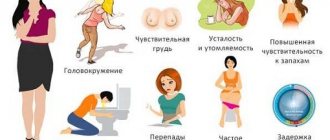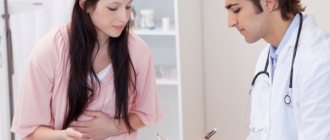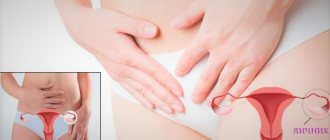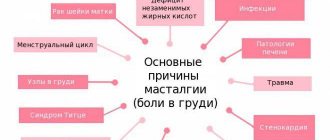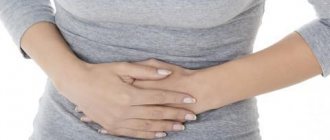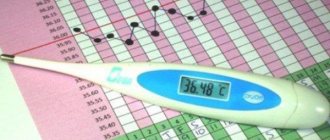Does the ovary pull after ovulation?
In 90% of cases, girls and young women complain of simultaneous pain in the ovarian region and at the lumbar level.
Banal prolonged hypothermia is the first reason for the occurrence of such unpleasant sensations. If hypothermia is excluded, then this indicates the presence of one or more pathologies of the genitourinary system, for the diagnosis of which the nature of the pain, frequency of occurrence, and also its duration are of great importance. Women who are faced with pain syndrome think about whether the appendage may hurt before ovulation. The answer is clear – pain is possible. They are caused by pressure from an enlarged ovary on nearby organs. Normally, discomfort does not affect performance and does not last too long. Their duration is 24-48 hours. The nature of pain before follicle rupture is as follows:
- Aching;
- Tingling;
- Pulling;
- Shooting;
- Shooting to the leg or lower back.
The character after ovulation pain is less intense. Most often, a woman feels heaviness and burning in the ovulated ovary. Symptoms indicate the functioning of the corpus luteum. It ensures the growth of progesterone. If fertilization takes place, the hormone will ensure successful implantation.
Many women come to the doctor complaining that their ovary hurts after ovulation. In such situations, the gynecologist talks about reproductive processes from a physiological point of view. Discomfort in one of the ovaries is considered completely normal. The appendage in which the corpus luteum formed after ovulation is painful. But if both ovaries hurt, it is advisable to be vigilant and consult a doctor. Possible reasons for this phenomenon include:
- Multiple ovulation;
- Adhesive process in the pelvis;
- Ectopic pregnancy;
- Infectious diseases;
- Endometriosis.
Ectopic pregnancy
With multiple ovulation, pain is due to excessive strain on the body. The eggs mature on both sides at once. This phenomenon is considered rare. Usually the ovaries work alternately. As a result of multiple ovulation, multiple pregnancies can be expected.
The inflammatory process in the pelvis develops as a result of the penetration of pathogenic microorganisms. The main complication of inflammation is the adhesive process. It disrupts the patency of the fallopian tubes and changes the position of the ovaries. Adhesions can cause pain in the appendages. They appear not only during ovulation, but also on other days of the cycle.
Abdominal pain
During ovulation, mainly one appendage hurts. But at the beginning of the follicular phase, discomfort may be present on both sides. This is due to the growth of follicles, as a result of which the volume of the ovaries increases. When a dominant follicle appears, the others begin to deflate. During rupture of the follicular walls, pain is felt only on one side.
An acute attack of pain may indicate rupture of the follicle with subsequent release of the egg beyond its boundaries. At this moment, a woman may notice a slight deterioration in her health. If the left ovary hurts in the middle of the cycle, ovulation occurs there. The cyclicity of the appendages is individual for each woman. For some representatives of the fair sex, the left appendage works better, for others, the right one.
Not in all cases, intense pain is considered normal. If the follicle was too voluminous, the ovary may rupture. In medicine, this deviation is called apoplexy. It poses a threat to the life and health of the patient. In case of acute pain syndrome, you should not let the situation take its course. You should immediately consult a doctor to determine the cause of the discomfort. The risk of apoplexy increases in the presence of cysts and MFN.
Apoplexy of the ovary
The reason why the ovary hurts after ovulation may be gynecological diseases. The most common of them include:
- Salpingitis;
- Cystic formations;
Salpingitis
If the right or left ovary pulls immediately after ovulation, this is most likely due to a rupture of the follicle. But the pain may increase due to inflammatory processes and pathology of the reproductive organs. For example, when a cyst ruptures, a sharp spasm is felt.
When the ovary tingles some time after ovulation, this may indicate pregnancy or a gynecological disease.
The main causes of pain in the side after ovulation:
- Follicle rupture;
- A sharp increase in progesterone;
- Individual characteristics of the body;
- External factors negatively affecting the process;
- Development of pathology of the reproductive organs;
Ovarian follicle
The pain can be of different types. More often than not, the ovulatory process is accompanied by a nagging or aching pain, sometimes cramping. If you experience stabbing or cutting pain, it is better to consult a doctor, as this may be a sign of a disorder of the reproductive system or a disorder due to ovarian dysfunction.
It is important for every woman to know why the ovary hurts after ovulation. In most cases, there are no unpleasant sensations or the woman simply does not notice them. The period starting after ovulation and ending with menstruation is called the luteal phase of the cycle. It is accompanied by an increase in hormones responsible for the development of pregnancy.
Most often, after ovulation, the right ovary hurts. According to statistics, it is in it that full-fledged eggs mature. This is due to the peculiarities of blood circulation in the female body. If at the same time after ovulation the left ovary also hurts, there is no need to worry. Discomfort may be the result of the resorption of small follicles that failed to become dominant.
Ovarian follicle
Often women confuse ovulatory pain in the right side of the peritoneum with symptoms of acute appendicitis. Incorrect diagnosis in this case can lead to serious complications. When the appendix is inflamed, in addition to abdominal pain, nausea, vomiting and pale skin appear. The diagnosis is made after palpation of the peritoneum.
Some women have pain in the left ovary. Ovulation may have nothing to do with this process. Among the possible causes of malaise are diseases of the digestive system. In this case, stool is disrupted and appetite disappears. Pain may spread to the epigastric region.
Once it becomes clear why the ovary hurts after ovulation, you can think about ways to eliminate the discomfort. Physiological pain goes away on its own after some time. To make you feel better, the following groups of drugs are allowed:
- Analgesics (Nise);
- Antispasmodics (No-shpa, Spazmalgon);
- Nonsteroidal tablets (Ibuprofen, Diclofenac).
Analgesic
If the ovary hurts after ovulation due to the development of salpingitis, anti-inflammatory therapy is carried out. Most often, the medicine is administered intravenously while the woman is in the hospital. For cystic formations, hormonal medications are prescribed. If treatment does not produce the desired effect, the tumor is removed surgically. Foci of endometriosis are eliminated in the same way. If adhesions have formed in the pelvic area, they are dissected under general anesthesia.
The embryo, instead of the uterine cavity, is often attached to the ovaries. As it grows, the risk of organ damage increases. If the problem is detected in a timely manner, it is possible to save the appendage completely or partially. Lack of timely qualified assistance can cause serious health complications.
For pain caused by implantation, standard painkillers will not help. The only thing a woman can do is limit physical activity. It is also advisable not to overcool and not take a hot bath. A lumbar massage can help you feel better. After a few days, the discomfort in the appendages will become less pronounced.
As you know, all women of childbearing age have their own individual menstrual cycle. It consists of 3 phases. In each period of the menstrual cycle, a woman may complain that the ovaries are pulling. Ovulation is accompanied by pain quite often. It is characterized by the release of an egg into the abdominal cavity.
This process is accompanied by changes in the gonads. The dominant follicle ruptures when the egg is released. During this period, some women experience unexpressed nagging pain in the right or left groin area. Unpleasant sensations occur on the side where the follicle ruptured.
Ovulation occurs in the middle of the menstrual cycle. In addition to discomfort in the ovarian area, it is accompanied by other symptoms. Among them are increased sexual desire and the release of clear, thick mucus from the vagina. Ovulation lasts only 1 day, during this period the probability of conceiving a child reaches its maximum.
A woman's reproductive cycle consists of two phases: ovulatory and luteal. The ovulatory phase of the cycle begins with the growth and maturation of the follicle - a miniature round-shaped formation in which the egg lives and develops, its preparation for release and fertilization. The process of follicle maturation takes 10-14 days. When the follicle matures, it increases in size and stretches the walls of the organ.
Nature of pain
Most often, patients whose right ovary hurts before menstruation complain of nagging or aching pain. The severity of pain varies from barely noticeable, not causing any noticeable discomfort, to severe. The intensity of pain depends on the cause of its occurrence and individual sensitivity. With functional cysts, pain in most patients is mild, but with other types of tumors it can be stronger.
Read more How to properly put on a urinal for a girl video
In the middle of the cycle, patients sometimes experience sharp sharp pains that quickly pass. This picture is typical for ovulatory syndrome.
With apoplexy of the ovary, rupture of the cyst, or torsion of its leg, unbearable dagger pain occurs. Some patients even lose consciousness due to painful shock.
Ovarian aches before menstruation
Aching sensations often occur in patients with low-grade inflammation. Sometimes ovarian cysts are found in women who come with complaints that the right ovary is aching before menstruation. In such situations, it is often discovered that a luteal cyst has formed. This is a functional neoplasm, which, even in the absence of treatment, goes away on its own within 2-3 months.
Colitis of the ovary before menstruation
Stitching sensations occur mainly during the period of ovulation. When the egg is released, the follicle ruptures and a small amount of blood can enter the abdominal cavity. If the cause of pain is ovulation, then the woman will feel discomfort 12-14 days before the start of menstrual flow.
Even a slight tingling sensation in the ovaries before menstruation can indicate serious illness. To exclude pathology, it is advisable to undergo an examination by a gynecologist and do an ultrasound of the reproductive system.
Pulling of the ovary before menstruation
Nagging pain can occur with the growth of cystic formations, polycystic disease, and inflammatory diseases. In some women, discomfort is caused by hormonal imbalance or structural features of the reproductive system. But situations are possible in which there are no pathologies, but the appendages constantly hurt before the onset of menstruation.
Causes of pain in the ovaries associated with the phases of the menstrual cycle
When using incorrectly selected hormonal drugs, ovarian hyperstimulation syndrome may develop. Blood pressure may drop, discomfort or severe pain may appear. Treatment requires adjustment of hormonal medications.
Adnexit
Pain requires treatment if the cause is adnexitis. Adnexitis (salpingoophoritis) – inflammation of the appendages. More often it manifests itself in an acute or chronic form. During this period, adhesions form on the pipes. With adnexitis, in addition to pain, a high temperature may be observed, and discharge with a purulent mass from the vagina itself is also possible.
Polycystic
With polycystic disease, a large number of growths form around the ovary. This interferes with the release of the egg. Symptoms of polycystic disease:
- failure and change in the menstrual cycle;
- hormonal disbalance;
- increase in hair growth, like in men;
- pain in the right or left ovary.
Polycystic disease requires mandatory treatment, otherwise it can lead to irreversible infertility.
Apoplexy
Apoplexy is rupture of the ovary. Hemorrhage occurs in the abdominal cavity. The right side is more likely to rupture. Remember, sharp, very strong, sharp, stabbing pain in the ovary is a very important symptom, indicating the need for urgent surgical intervention.
A very common occurrence is ovulatory syndrome. Pain in the ovarian area in women after ovulation can be caused by partial detachment of the uterine mucosa due to impaired hormone levels. During ovulation, discomfort may also occur. They are a normal phenomenon, except for the situation when the pain is acute and lasts more than a day, there is an increase in body temperature.
It is not recommended to treat diseases of this group on your own. After determining the diagnosis, the doctor will prescribe the necessary medications. Very often, antibiotics and anti-inflammatory drugs are needed for treatment.
The symptoms of all diseases associated with the appearance of pain in the ovaries in women are similar to each other, so you should immediately visit a doctor, otherwise there may be consequences, including infertility and even death.
Throughout the entire menstrual cycle, a woman’s reproductive organs and hormone levels change. Likewise, the ovaries are constantly undergoing changes.
During ovulation
Some women do not feel signs of ovulation. Others, on the contrary, say that the pain in the ovarian region during this period acquires a stabbing, pulling character. Brief discomfort does not pose a threat to the body and does not require any treatment. This is due to the rupture of the follicle, which releases a mature egg for conception.
Also, during ovulation, the ovary may prick due to exacerbation of inflammatory processes in the pelvic organs (adnexitis, oophoritis). At the same time, after training, stress, or lifting weights, unusual discharge is observed. To reduce pain and relieve discomfort in the lower abdomen, a woman is recommended to take analgesics (Spazmalgon, No-Shpa).
If after taking a painkiller the ovaries still hurt, then the reason is not ovulation. The patient needs to consult a doctor, be examined, and begin appropriate treatment. Remember! Each woman experiences ovarian pain differently. It all depends on age, chronic diseases, pain threshold and other individual characteristics of the body.
During your period
It is considered normal if pain in the ovaries appears a few days before the start of menstruation and becomes stronger during it. On the first day, women feel mild nausea and dizziness. The nature of the pain is twisting, stabbing, aching. There are cases when, towards the end of menstruation, a woman begins to vomit.
Lifting weights, overwork, disturbances in the psycho-emotional state, and constant stressful situations lead to an increase in pain and a worsening of a woman’s general well-being. What can be done in this situation and how to reduce the pain? No treatment is required for painful periods. A woman just needs to take a painkiller (for example, Tamipul) or apply a warm heating pad to her lower abdomen.
During menopause
Menopause is accompanied by a series of hormonal changes in the body due to the lack of bleeding. She appears individually. Menopause occurs at the age of 45-50 years. The onset of menopause can provoke pain in the ovaries, but such pain does not last long. During this period, a woman is more susceptible to infections and viruses.
The following are the causes of pain in the ovaries after menopause:
- inflammation;
- cyst;
- malignant tumors.
Pain in the ovaries is accompanied by changes in vaginal tissue, frequent urination, sweating, impaired bowel movements, and increased body temperature. Therapy depends on the nature of the complaints and the identified cause of discomfort.
As mentioned earlier, if pain in the ovaries lasts more than two to three days, and discharge of an uncharacteristic color and odor appears, this indicates a disease of the pelvic organs. Most often it is inflammation, cystic neoplasm, cancer, miscarriage or ectopic pregnancy. Let's look at each reason in more detail.
Inflammation of the ovaries
Inflammation may be accompanied by severe pain in the lower abdomen and fever. It can be unilateral (affects one appendage) or bilateral (occurs on two ovaries at once). In acute inflammation, the following symptoms appear:
- sudden severe pain in the ovarian area;
- fever;
- chills;
- purulent vaginal discharge;
- abdominal cramps;
- constipation;
- nausea.
Due to lack of treatment and resulting scarring, symptoms may persist for years, even after healing. If there is a sharp stabbing in the lower abdomen, then the ovary is inflamed. The occurrence of infection of the appendage is influenced by:
- frequent change of sexual partners;
- vaginal contraceptives (spiral);
- smoking;
- regular vaginal douching;
- curettage, abortion.
Treatment of pelvic inflammatory diseases occurs with the help of oral antibiotics and vaginal suppositories. Therapy depends on the nature and severity of the pathology. If the ovaries are very painful, the symptoms are pronounced, up to loss of consciousness, hospitalization and intravenous antibiotics are required.
Cystic formation on the ovary
Formed in a woman who has reached puberty. Symptoms of a cyst depend on its size. Small lesions of just a few centimeters usually do not cause discomfort. Mostly they are discovered by chance, and their growth is then monitored without using any medications. Cysts larger than 2 cm manifest as urinary problems.
Sometimes a girl may feel a nagging pain (spasm) in the lower abdomen. Formations larger than 5 cm begin to put pressure on neighboring organs, causing tingling in the ovary or cutting pain. A sudden worsening of symptoms that accompanies bleeding indicates complications, such as twisting of the fallopian tubes or rupture of the formation.
What to do if the ovaries hurt due to a cyst? Treatment methods depend on the size and type of cyst (retention, polycystic, follicular), clinical signs, and age of the patient. If extremely large ovarian cysts are detected, hormonal drugs or surgery are prescribed. If, after treatment with hormones, the appendages continue to hurt, and the formation increases in size, doctors decide on an urgent operation (laparoscopy, laparotomy).
A common malignant neoplasm that affects the female body regardless of age. It can be unilateral or bilateral. What causes cancer and severe pain in the ovarian area, what are the risk factors? Women over 30 years of age are more susceptible to developing pathology. Genetic predisposition and infertility play an important role.
Symptoms of cancer:
- change in the duration of menstruation;
- profuse uterine bleeding with clots;
- severe pain in the lower abdomen;
- on the infection side, the ovary begins to pull or tug;
- increase in waist circumference, abdominal asymmetry;
- fatigue;
- bloating;
- dyspepsia.
Metastases most often occur on both sides. Of these, about 30% reaches the uterus, and 20% reaches the mammary glands. In addition, if the ovary tingles and the cancer is already at the last stage, metastases can move to neighboring organs - the stomach, liver, lungs. If the ovary twists, a sharp, shooting pain appears; a feeling of fullness means that the malignant tumor has reached the intestines and bladder.
Why do the ovaries hurt before menstruation: the most common causes
Some women suffer from irregular periods, while others experience regular periods. If in most cases women feel a tug in their lower abdomen, then other representatives of the fairer sex face another problem - pain in the ovaries. Unpleasant sensations may occur a week before or during menstruation. They make you seriously concerned about your health. The causes of pain can be very diverse.
Perhaps you were overcooled, after which inflammatory processes occurred in the ovaries. Only a gynecologist can tell you the exact cause of pain as a result of an ultrasound. Why should you definitely contact him? A specialist will help you determine the cause of your discomfort based on the duration, frequency, and nature of the pain. Pain can be an alarming signal that informs about the presence of various diseases of the reproductive system. Sometimes pain in the ovaries can be mistaken for pain in the pubic area, lower abdomen or lower back.
A common cause of pain in the ovaries is the presence of a cyst. It is a fluid-filled neoplasm emerging from the follicle. From an anatomical point of view, the cyst looks like a sac with thin walls. Its dimensions can reach twenty centimeters in diameter. Most cysts are functional or follicular. It appears at the moment of overripening of the follicle, in which the female reproductive cell is formed. Since each follicle must mature and rupture, a cyst appears in the place of a follicle that, for some reason, did not rupture in the prescribed time, but continued to mature.
Hormonal imbalances, tumors, abnormal development of the internal genital organs or abnormal positions of the appendages are not a complete list of reasons why the ovary hurts during menstruation.
We recommend you find out: Reasons why the left ovary hurts
Help with nagging pain in the ovary
Painful sensations of a pulling nature may occur after ovulation. During this period, a large amount of the hormone progesterone is released. In the absence of pregnancy, a woman’s body prepares for the rejection of the endometrium - menstruation. Women during this period often complain that the left ovary is pulling (or the right, depending on the location of the dominant follicle).
The ovary is a glandular organ of the female reproductive system, in which changes occur constantly. Pain can not only accompany ovulation, but also continue for several days after it. After all, the gland tissue undergoes physiological damage during follicle rupture. Healing occurs in a short period of time and is not accompanied by severe pain.
If the discomfort continues for a long time, you should consult a gynecologist. In addition, indications for consulting a doctor are nagging pain of high intensity that is constant. They may indicate the occurrence of cystic formations, an inflammatory process, or the onset of an ectopic pregnancy. All these pathologies require immediate treatment.
A condition in which you should especially carefully monitor your health is pregnancy. Many women have retracted ovaries during this period. Most often, this symptom occurs at the beginning or end of pregnancy. In fact, the unpleasant sensations that a woman perceives as pain in the ovaries are associated with stretching of the uterine ligaments.
The fact is that while carrying a child, significant changes occur in the entire body, including the genitals. Often patients go to the doctor with a complaint such as ovarian tugging before menstruation. For many women, this symptom indicates the development of pregnancy. Changes associated with carrying a child occur already in the first trimester.
In most cases, discomfort in the lower abdomen is caused by sprained ligaments. They are located in the same place as the ovaries. For this reason, pain is easily confused with the discomfort that is observed with adnexitis and other pathologies of the gonads. Despite this, there is a possibility that the woman actually has an ovarian pull.
Pain in the appendage area in pregnant women is quite dangerous. If the ovary pulls in the early stages, you should pay attention to the intensity of the discomfort. Mild pain may indicate implantation of the embryo into the uterine tissue. However, such discomfort quickly passes. If the pain lasts for several days or gets worse, you should consult a doctor immediately.
One of the life-threatening conditions is ectopic pregnancy. This means that the fetus is attached to the tissue of the appendages. Most often, tubal pregnancy is diagnosed, but its development in ovarian tissue is also possible. The development of the embryo leads to stretching and rupture of the appendages. In this case, signs of pregnancy are observed, such as increased levels of hCG in the urine, nausea, delayed menstruation and an enlarged uterus.
If the left ovary pulls for a long time, this may indicate adnexitis. The inflammatory process during pregnancy is particularly dangerous, as it leads to complications. In addition, many medications are contraindicated while carrying a child. Pain in the left half of the abdomen can be observed with constipation due to stretching of the sigmoid colon.
A nagging pain in the ovaries is observed for several days after drug manipulation. These include procedures such as in vitro fertilization, removal of cystic formations, tubal ligation, etc. The recovery period after any surgical intervention on the appendages is accompanied by pain.
Normally, this lasts for 2-3 days. In this case, there should not be a pronounced increase in temperature and other inflammatory symptoms. One of the stages of the IVF procedure is the transfer of embryos into the uterine cavity. This process is accompanied by a hormonal reaction from the ovaries. Therefore, slight nagging pain is considered normal in this case.
Treatment for nagging pain in the ovarian area depends on the cause of its occurrence. To temporarily relieve discomfort, antispasmodics are prescribed. These include the drugs “No-shpa” and “Drotaverine”. Ovarian cysts are an indication for hormonal therapy. Oral contraceptives “Jess”, “Janine”, etc. are used.
Ectopic pregnancy itself is not a disease, but it is a serious pathology that threatens the patient’s life. At the initial stage of pregnancy, painful sensations occur, often on one side of the abdomen. Starting from 5-6 weeks of pregnancy, rupture and damage may occur in the place where the fetus is located. It is worth undergoing an ultrasound examination and be sure to visit a gynecologist if bleeding appears. Also, nagging pain in a woman’s ovaries can indicate other serious pathologies of pregnancy, such as:
- placental abruption;
- low presentation of the fetus;
- uterine tone;
- hypoxia.
During pregnancy, complaints of pain in the lower abdomen and lumbar region are due to an increase in the load on the spinal column. But in the early stages of pregnancy, when the weight of the fetus and the weight of the woman herself have not yet increased significantly, such complaints may signal a threat of miscarriage. If the pulling sensation does not cause pain, but is quite uncomfortable and occurs after the 20th week, false Braxton-Hicks contractions can be suspected.
Ovarian follicle
Can the ovaries hurt before menstruation?
The appearance of pain in the ovaries before menstruation is caused by disturbances in the reproductive system. In the middle of the cycle, a mature egg is released from the follicle, and in its place a corpus luteum is formed, which is responsible for the production of the phase 2 hormone - progesterone. With the formation of an incomplete corpus luteum, the production of progesterone is impaired. Because of this, endometrial detachment may begin even before the start date of menstruation. This process is accompanied by pain.
This is not the only reason for unpleasant sensations. When conducting a comprehensive examination, doctors often identify diseases that cause pain.
Gynecological pathologies of the ovaries
To relieve pain after ovulation or prevent it, it is necessary to follow preventive measures.
- 3-5 days before the ovulation period, drink plenty of water.
- Avoid stress, stay calm. You can drink valerian, Persen.
- Go to bed before 23.00, get enough sleep, sleep should be at least 7 hours.
- Avoid physical strain.
- Eat properly. Avoid fast food, sweets, fatty foods, and alcohol.
- Don't have rough sex.
Sometimes doctors prescribe vitamin complexes that improve the functioning of the reproductive system.
Excessive release of female sex hormones is also harmful to the body. Hyperestrogenism is one of the main predisposing factors in the development of oncological processes of the cervix, endometrium and ovaries. In addition, hormonal imbalance can lead to breast cancer.
- Increased temperature and general weakness.
- Menstrual irregularities.
- Increased pain during sexual intercourse and physical activity.
- The appearance of vaginal discharge of an unusual color and with an unpleasant odor.
- Pain when urinating.
If these symptoms appear, you should be examined by a gynecologist. In some cases, consultation with other specialists is necessary - an infectious disease specialist, nephrologist, endocrinologist, oncologist.
How to get rid of pain?
Painkillers help with ovulatory syndrome; they quickly eliminate discomfort. If a woman knows about this feature of her body, then she can take the pill in advance, before ovulation.
The table shows a list of painkillers:
| No. | Name | Active substance | Characteristic |
| 1 | Nurofen | Ibuprofen | NSAIDs have analgesic, antipyretic and anti-inflammatory effects. |
| 2 | Ketanov | Ketorolac | NSAIDs, relieves pain and inflammation. |
| 3 | Analgin | Metamizole sodium | Analgesic-antipyretic. |
Several recommendations on how to behave during ovulatory syndrome:
- avoid physical activity;
- exclude from the diet foods that cause excess gas formation - apples, beans, cabbage;
- make a warm foot bath, but do not put heat on your stomach;
- minimize emotional stress.
If the pain becomes too severe, you should consult a gynecologist. The doctor will be able to make an accurate diagnosis and prescribe adequate treatment.
https://youtu.be/QCG_cQnd_3M
What diseases can there be
Unlike the uterus, the ovaries are literally entangled with nerve endings, so they react with pain to any disturbance, to any pathology occurring in them.
The ovaries are a very sensitive organ
Salpingo-oophoritis
The most common ovarian disease is considered to be inflammation of one or both organs - oophoritis, inflammation of the fallopian tubes (salpingitis). More often, both the ovaries and fallopian tubes are affected by inflammation. Then we are talking about salpingoophoritis or adnexitis. The disease occurs in acute or chronic form and occurs as a result of pathogenic bacteria entering the ovaries. This happens as a result:
- active sexual activity with an infected partner, since the likelihood of getting an infection increases with frequent changes of partners;
- inflammatory processes in organs close to the appendages: in the uterus, bladder, in the lower intestine;
- abortions, childbirth, surgical interventions.
The consequence of oophoritis is the absence of ovulation and infertility. Salpingitis leads to adhesions and obstruction of the fallopian tubes, which is also a cause of infertility.
To determine the cause, the doctor must conduct a diagnosis
Symptoms of acute oophoritis are:
- acute pain in the lower abdomen from the inflamed ovary;
- elevated temperature;
- urination disorder;
- weakness, deterioration of general condition.
Treatment is prescribed by the doctor after examination and determination of the cause of the disease.
Polycystic ovary syndrome
Polycystic ovary syndrome is a fairly common pathology.
Benign tumors of the reproductive organ are divided into epithelial and connective tissue. The main type of benign connective tissue tumor is ovarian fibroma. This disease affects women of reproductive age. For a long time it is asymptomatic. If left untreated, complications arise, such as torsion of the tumor stalk, tumor suppuration and necrosis. Benign tumors are diagnosed by ultrasound, CT scan or biopsy.
Ovarian cancer is diagnosed at any age, most often during reproductive age. A malignant tumor arises and develops from the epithelial tissue of the ovary. Symptoms of the disease appear at a late stage.
- bleeding from the vagina;
- enlargement of the abdomen due to fluid accumulation;
- frequent urination, constipation,
- pain.
If you have ovarian cancer, you may experience frequent urination.
One of the causes of cancer is genetic predisposition. If there were women in the family who had cancer, this means that the woman is at risk and should be examined for oncology at least once every six months.
The main diagnostic method is ultrasound examination of the pelvic organs. It can be used to visualize changes in the size and structure of the ovaries, and follicular disorders. Before performing an ultrasound, the doctor studies complaints and anamnesis, and conducts a gynecological examination. In some cases, other diagnostic methods are required - hysterosalpingography, organ biopsy.
Diagnosing the reasons why they hurt includes:
- taking an anamnesis;
- gynecological examination and palpation;
- cytological and hormonal studies;
- colposcopy, laparotomy, laparoscopy;
- Ultrasound;
- X-ray (in the presence of cancer).
Treatment
Inflammation of the ovaries
Can my ovaries hurt after a miscarriage? Spontaneous abortion is the premature termination of pregnancy during the first 20 weeks, when the fetus is not yet able to survive outside the uterus. About 10-15% of women experience pain after a miscarriage. More than 40% of all pregnancies end in spontaneous abortion, with the majority unaware of the presence of a fetus.
After a miscarriage, pain in the lower abdomen lasts for some time as the uterus contracts and returns to normal. Brown or red discharge may appear on your underwear. If they last more than two weeks after a miscarriage, you should go to the hospital. Why is it necessary to visit a doctor for such prolonged discharge?
After a miscarriage, women often struggle with feelings of guilt, blaming themselves for the situation. Depressed mood, hysteria, psychological trauma have a direct impact on the nervous system. Migraines, body aches, and poor health appear. Painful symptoms worsen.
An ectopic pregnancy is manifested by improper attachment of the fertilized egg. So, the embryo can be placed on the fallopian tube or ovary. As the woman grows, she first develops a nagging pain, then a sharp pain.
If a woman has pain in her ovaries during pregnancy, then most likely she has inflammation, hormonal imbalance or a corpus luteum cyst.
Thus, pain in the ovary has a different cause. Sometimes the “culprit” for discomfort in the lower abdomen is ovulation or menstruation. But, unfortunately, very often pain indicates the development of one or another pathology. That is why, if unusual sensations appear, you should definitely consult a doctor. Remember!
